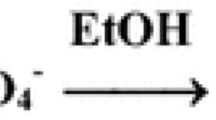Abstract
THE formation of more than one zone containing phosphate when the sodium orthophosphates are chromatographed on paper suggests that these spots contain different molecular species originating in proton transfer equilibria of the kind:  where B−n is a base1,2. The speed of proton transfers, for example, the half-life for the reaction of hydronium and hydroxyl ions is 10−8 sec3, argues against this as such equilibria yield multiple spots only if the transition time is comparable with the time required for the formation of the chromatogram4. It is natural to question next if the zones are actually of different species since discontinuities in either the immobile or mobile phases can also produce the result4. Chromatograms of orthophosphoric acid and of the primary, secondary, and tertiary sodium salts were formed on 55 cm × 2.8 cm strips of Whatman No. 1 filter paper, acid washed, which had also been washed in 2 M acetic acid followed by three successive rinsings in distilled water5. The chromatograms were formed either with pyridine/ethyl acetate/water (the faster solvent) or butanol/water. Fig. 1 is a photograph of 10 µl. of 0.01 M trisodium phosphate (No. 321) and 10 µl. of 0.01 M sodium dihydrogen phosphate (No. 322) formed simultaneously with BuOH/15 per cent H2O. The origin was the vertical pencil line adjacent to the numbers. When revealed, the colour process was that employing ammonium molybdate and benzidine hydrochloride6. In certain select cases, the multiple spots were irradiated in the University's Triga reactor7,8. Both sodium and phosphorus undergo (n,γ)·reactions to form radioactive isotopes which decay as follows9,10:
where B−n is a base1,2. The speed of proton transfers, for example, the half-life for the reaction of hydronium and hydroxyl ions is 10−8 sec3, argues against this as such equilibria yield multiple spots only if the transition time is comparable with the time required for the formation of the chromatogram4. It is natural to question next if the zones are actually of different species since discontinuities in either the immobile or mobile phases can also produce the result4. Chromatograms of orthophosphoric acid and of the primary, secondary, and tertiary sodium salts were formed on 55 cm × 2.8 cm strips of Whatman No. 1 filter paper, acid washed, which had also been washed in 2 M acetic acid followed by three successive rinsings in distilled water5. The chromatograms were formed either with pyridine/ethyl acetate/water (the faster solvent) or butanol/water. Fig. 1 is a photograph of 10 µl. of 0.01 M trisodium phosphate (No. 321) and 10 µl. of 0.01 M sodium dihydrogen phosphate (No. 322) formed simultaneously with BuOH/15 per cent H2O. The origin was the vertical pencil line adjacent to the numbers. When revealed, the colour process was that employing ammonium molybdate and benzidine hydrochloride6. In certain select cases, the multiple spots were irradiated in the University's Triga reactor7,8. Both sodium and phosphorus undergo (n,γ)·reactions to form radioactive isotopes which decay as follows9,10: 
Similar content being viewed by others
References
Curry, A. S., Nature, 171, 1026 (1953).
Erdem, B., Rev. fac. sci. univ. Istanbul, 20c, 332, 346 (1955); Chem. Abstr., 50, 16530g (1956).
Bell, R. P., The Proton in Chemistry (Cornell Univ. Press, Ithaca, New York, 1959).
Keller, R. A., and Giddings, J. C., J. Chromatog., 3, 205 (1960); in Chrom. Rev., edit. by Lederer, M., 3, 1 (1961).
Hanes, C. S., and Isherwood, F. A., Nature, 164, 1107 (1949).
Block, R. J., Durrum, E. M., and Zweig, G., A Manual of Paper Chromatography and Paper Electrophoresis (Academic Press, New York, 1958).
Isbin, H., Proc. Second U.N. Intern. Conf. Peaceful Uses Atomic Energy, Geneva, 8, 561 (1958).
Koutz, S. L., Taylor, T., McReynolds, A., Dyson, F., Stone, R. S., Sleeper, jun., H. P., and Duffield, R. B., Proc. Second U.N. Intern. Conf. Peaceful Uses Atomic Energy, Geneva, 10, 282 (1958).
Overman, R. T., and Clark, H. M., Radioisotope Techniques (McGraw-Hill Book Co., New York, 1960).
Friedlander, G., and Kennedy, J. W., Introduction to Radiochemistry (John Wiley and Sons, Inc., New York, 1949).
Koch, R. C., Activation Analysis Handbook (Academic Press, New York, 1960).
Weinberg, B. B., and Keller, R. A., J. Chromatog. (in the press).
Partridge, S. M., Biochem. J., 42, 238 (1948).
Author information
Authors and Affiliations
Rights and permissions
About this article
Cite this article
KELLER, R., ROMMEL, M. Circumstances of Multi-spot Paper Chromatograms of Sodium Orthophosphates: in situ Identification of the Species. Nature 204, 873–875 (1964). https://doi.org/10.1038/204873a0
Issue Date:
DOI: https://doi.org/10.1038/204873a0
- Springer Nature Limited





